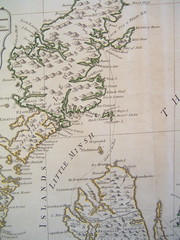Silences About Property Law: What are the Digital Humanities FOR?
The history of property ownership as we know it is one of the best-documented subjects in the university, the subject of concentration by economists, historians, law school professors, philosophers, and anthropologists. It is also a subject with an impressive century-long hole in it, from approximately 1870 to 1980, during which time period a global debate about property ownership happened which almost no one has written about. It is exactly the sort of subject that digital tools for reading massive archives were built to handle: global, massive, almost entirely uncharted, deeply relevant, and open to debate.
In 1870, a historian named James Godkin inspired a newly phase of political resistance geared at the distribution of land by publishing a new account of Ireland’s struggles against England, The Land-War in Ireland, which framed contemporary struggles in terms of ancient rights to land ownership abrogated by colonizing invaders, who since Spenser’s time had used rent and eviction as the major tools for terrorizing the colonized. In the generation after Godkin’s book, Irish resistance changed from guerilla struggles to organized rent-strikes that placed land ownership at the center of their work. The era of the Irish “Land War” had begun.
In the 1880s and 1890s, rent strikes and other rebellions influenced by the Irish spread to Scotland, England, and New York, where organized campaigns against paying rent became the major tool of urban immigrants in protecting their incomes, successful in many areas where unionized labor strikes were still illegal and their gains meager. More importantly, Godkin had thrown into question the ultimate justice of colonizing powers’ right to land, and made possible the abrogation of claims of property ownership by previously excluded and oppressed citizens, who, in the tradition of the French Revolution, restated their claim to economic and political participation on the basis of universal rights, in this case the right to own property, the right to be free from eviction, typically phrased as “the right of the tiller to the soil.” Through the popular journalism of the San Francisco-born international political pundit Henry George, previous legal traditions of public property were reworked through a broad challenge to the legacy of empire and class privilege. In the writings of Fabian socialists like Annie Besant, land reform became canonized into a new agenda for socialism. In the writings of legal reformers like Frederick Maitland and Paul Vinogradoff, the folk ownership of the land in the middle ages provided a precedent for state collectivization of land in the service of infrastructure and housing for the people.
This robust intellectual foundation provided the basis for national politics around the reform. By 1914, every political party in Britain supported some version of a land reform agenda in Britain’s Parliament. In postcolonial Mexico, arguments for land reform echoing the Haitian revolution urged on land reforms capable of reversing imperial concentration of the land into haciendas. For similar reasons of reversing aristocratic control, the League of Nations urged land reform upon imperial China in the 1930s. By 1945, national programs of land management, mortgages, and public housing were on the agenda in every developed nation in the world. By 1946, the United Nations’ Food and Agriculture Organization dedicated large portions of its administration to the collection of land tenure policies and statistics from the rest of the world, with the agenda of supplying legal and economic advisors to developing nations seeking to emulate land reform in Europe and America.
The result of so much policy shift was the manufacture, between 1880 and 1980, of masses of documents, historical, legal, and economic, examining the past and future of land reform in every country in the world. Hundreds of historians, sociologists, anthropologists and economists in Europe and North America took the global history of land as their subject for their dissertation research, assured that their work would find committed readerships in international policy.
Then, precipitously, around 1982, political opinion turned against the land reformers. The Right, influenced by Milton Friedman, argued that land was just like any other commodity, best left to the market rather than the state. The American left repeated Richard Hofstadter’s critique of the “Agrarian Myth” in nineteenth-century American; at the heart of their dismissal echoed something like Lenin’s critique of the peasantry – against decades of Latin American and Asian experience – that the revolution would come from city-dwellers, not from peasants, and therefore by union organization, not by land reform or rent strikes.
As a result of this about-face, a devastating silence followed, where barely a historian touched the global century or more of land reform for some thirty years. A few aging agrarian economists who had spent their lives working in development wrote memorials to land reform, pondering why it went away when it was doing such a good job of distributing incomes. But most historians pretended to bury the subject, until now. A few years ago, a few brazen Britons, Paul Readman and Matthew Cragoe, began to unpack the English example and to show that land reform really had mattered.
But no one dared to touch the global question – what was land reform, and what happened to it? It was a formidable question, for it aims straight at a broad consensus in political science and economic policy that has a stranglehold over world events at the moment, not least the global political stagnation around environmental regulation.
The more we know about land reform, the more we realize that there is abundant political and legal precedence for broadcast regulation of land and water in the service of the people. Foundations of modern economic consensus begin to fall apart, namely that private property is an unchanging, easily formulated category; that it has ever been so and has always been apparent; that a golden age of pre-welfare-state capitalism existed in the glorious years 1880-1920 that we should turn back to; and that private property and land and water in particular cannot be made into public utilities without destroying the entire market economy.
Pursuing questions such as these is methodologically as well as intellectually difficult. It is hard for a few historians with to take on a subject whose archives stretch over decades, let alone transnational centuries. There is far too much paper to read. And that makes it ideally suited to a methodological innovation at the heart of the American university right now. At the root of the questions of digital methodology – of which tools and data we collect and how – are questions about how we address silences such as these. If we use digital tools to address long-term questions, we raise the possibility that a mere historian (a humanist mind you, schooled in reading and writing and the digital, not in STEM), can beg to tangle with economists, indeed with a consensus all the way across political policy today.
In the era of big data, we face methodological opportunities for placing the long-term analysts and the short-term analysts in conversation with each other. This is particularly appealing to those of us embarking on a digital turn in which questions of big data and their analysis are at the forefront of our activity. In an era in which the manipulation of large-scale aggregate data over space and time has become easier than ever, scholars in disciplines with adverse proclivities to short- and long-term storytelling face the option of allowing their data to speak to each other. The question of long-term or short-term history has a methodological aspect in the digital humanities, and it is this tension that governs the rest of this chapter.
Under the domain of the short in time come the intensive digitization and analysis of a perfect corpus -- the poetry of Gertrude Stein coded for different types of speech acts, the plays of William Shakespeare coded as to the gender of the speaker, maps showing speech acts next to demographics in the pre-Civil War South, county-by-county. Into this category fall the digital editions favored by the Society for Textual Scholarship and a great deal of beautiful digital cartography. Deep studies informed by many documents, they are short merely in the number of lifetimes under study.
Of the longue-durée type there are far fewer. There's the theorizing by the occasional maverick like Franco Moretti, whose Maps, Graphs, and Trees forced a hundred studies of the novel over five- and ten-year periods into a synthesis of a hundred years. There are the trade maps of the long eighteenth-century made by Ben Schmidt. There are collaborative projects like the Enlightenment of Letters. We might add N-grams, allowing as they do the imagination to analyze the use of the word "fancy" over three hundred years. These projects, like those in the first category, are also intensive in terms of corpus, but their analysis tends to be whittled down to one question -- the social network, changes in word frequency, or the shape of geography.
We need to question the prioritization of short-duree over longue durée, to hold up to question the advisor's mandate that narrowing to an appropriate question requires narrowing over time. Digital methods, with their powers of mass aggregation, raise important questions about how these tools are best put to use -- whether in reading the entire corpus of a single author of a single nation. Perhaps the frontier of doing history is bigger than any category we yet understand, slipping into questions of comparative empires, comparative debt regimes, comparative social protest methods, stretching across centuries as well as continents.
In 1870, a historian named James Godkin inspired a newly phase of political resistance geared at the distribution of land by publishing a new account of Ireland’s struggles against England, The Land-War in Ireland, which framed contemporary struggles in terms of ancient rights to land ownership abrogated by colonizing invaders, who since Spenser’s time had used rent and eviction as the major tools for terrorizing the colonized. In the generation after Godkin’s book, Irish resistance changed from guerilla struggles to organized rent-strikes that placed land ownership at the center of their work. The era of the Irish “Land War” had begun.
In the 1880s and 1890s, rent strikes and other rebellions influenced by the Irish spread to Scotland, England, and New York, where organized campaigns against paying rent became the major tool of urban immigrants in protecting their incomes, successful in many areas where unionized labor strikes were still illegal and their gains meager. More importantly, Godkin had thrown into question the ultimate justice of colonizing powers’ right to land, and made possible the abrogation of claims of property ownership by previously excluded and oppressed citizens, who, in the tradition of the French Revolution, restated their claim to economic and political participation on the basis of universal rights, in this case the right to own property, the right to be free from eviction, typically phrased as “the right of the tiller to the soil.” Through the popular journalism of the San Francisco-born international political pundit Henry George, previous legal traditions of public property were reworked through a broad challenge to the legacy of empire and class privilege. In the writings of Fabian socialists like Annie Besant, land reform became canonized into a new agenda for socialism. In the writings of legal reformers like Frederick Maitland and Paul Vinogradoff, the folk ownership of the land in the middle ages provided a precedent for state collectivization of land in the service of infrastructure and housing for the people.
This robust intellectual foundation provided the basis for national politics around the reform. By 1914, every political party in Britain supported some version of a land reform agenda in Britain’s Parliament. In postcolonial Mexico, arguments for land reform echoing the Haitian revolution urged on land reforms capable of reversing imperial concentration of the land into haciendas. For similar reasons of reversing aristocratic control, the League of Nations urged land reform upon imperial China in the 1930s. By 1945, national programs of land management, mortgages, and public housing were on the agenda in every developed nation in the world. By 1946, the United Nations’ Food and Agriculture Organization dedicated large portions of its administration to the collection of land tenure policies and statistics from the rest of the world, with the agenda of supplying legal and economic advisors to developing nations seeking to emulate land reform in Europe and America.
The result of so much policy shift was the manufacture, between 1880 and 1980, of masses of documents, historical, legal, and economic, examining the past and future of land reform in every country in the world. Hundreds of historians, sociologists, anthropologists and economists in Europe and North America took the global history of land as their subject for their dissertation research, assured that their work would find committed readerships in international policy.
Then, precipitously, around 1982, political opinion turned against the land reformers. The Right, influenced by Milton Friedman, argued that land was just like any other commodity, best left to the market rather than the state. The American left repeated Richard Hofstadter’s critique of the “Agrarian Myth” in nineteenth-century American; at the heart of their dismissal echoed something like Lenin’s critique of the peasantry – against decades of Latin American and Asian experience – that the revolution would come from city-dwellers, not from peasants, and therefore by union organization, not by land reform or rent strikes.
As a result of this about-face, a devastating silence followed, where barely a historian touched the global century or more of land reform for some thirty years. A few aging agrarian economists who had spent their lives working in development wrote memorials to land reform, pondering why it went away when it was doing such a good job of distributing incomes. But most historians pretended to bury the subject, until now. A few years ago, a few brazen Britons, Paul Readman and Matthew Cragoe, began to unpack the English example and to show that land reform really had mattered.
But no one dared to touch the global question – what was land reform, and what happened to it? It was a formidable question, for it aims straight at a broad consensus in political science and economic policy that has a stranglehold over world events at the moment, not least the global political stagnation around environmental regulation.
The more we know about land reform, the more we realize that there is abundant political and legal precedence for broadcast regulation of land and water in the service of the people. Foundations of modern economic consensus begin to fall apart, namely that private property is an unchanging, easily formulated category; that it has ever been so and has always been apparent; that a golden age of pre-welfare-state capitalism existed in the glorious years 1880-1920 that we should turn back to; and that private property and land and water in particular cannot be made into public utilities without destroying the entire market economy.
Pursuing questions such as these is methodologically as well as intellectually difficult. It is hard for a few historians with to take on a subject whose archives stretch over decades, let alone transnational centuries. There is far too much paper to read. And that makes it ideally suited to a methodological innovation at the heart of the American university right now. At the root of the questions of digital methodology – of which tools and data we collect and how – are questions about how we address silences such as these. If we use digital tools to address long-term questions, we raise the possibility that a mere historian (a humanist mind you, schooled in reading and writing and the digital, not in STEM), can beg to tangle with economists, indeed with a consensus all the way across political policy today.
In the era of big data, we face methodological opportunities for placing the long-term analysts and the short-term analysts in conversation with each other. This is particularly appealing to those of us embarking on a digital turn in which questions of big data and their analysis are at the forefront of our activity. In an era in which the manipulation of large-scale aggregate data over space and time has become easier than ever, scholars in disciplines with adverse proclivities to short- and long-term storytelling face the option of allowing their data to speak to each other. The question of long-term or short-term history has a methodological aspect in the digital humanities, and it is this tension that governs the rest of this chapter.
Under the domain of the short in time come the intensive digitization and analysis of a perfect corpus -- the poetry of Gertrude Stein coded for different types of speech acts, the plays of William Shakespeare coded as to the gender of the speaker, maps showing speech acts next to demographics in the pre-Civil War South, county-by-county. Into this category fall the digital editions favored by the Society for Textual Scholarship and a great deal of beautiful digital cartography. Deep studies informed by many documents, they are short merely in the number of lifetimes under study.
Of the longue-durée type there are far fewer. There's the theorizing by the occasional maverick like Franco Moretti, whose Maps, Graphs, and Trees forced a hundred studies of the novel over five- and ten-year periods into a synthesis of a hundred years. There are the trade maps of the long eighteenth-century made by Ben Schmidt. There are collaborative projects like the Enlightenment of Letters. We might add N-grams, allowing as they do the imagination to analyze the use of the word "fancy" over three hundred years. These projects, like those in the first category, are also intensive in terms of corpus, but their analysis tends to be whittled down to one question -- the social network, changes in word frequency, or the shape of geography.
We need to question the prioritization of short-duree over longue durée, to hold up to question the advisor's mandate that narrowing to an appropriate question requires narrowing over time. Digital methods, with their powers of mass aggregation, raise important questions about how these tools are best put to use -- whether in reading the entire corpus of a single author of a single nation. Perhaps the frontier of doing history is bigger than any category we yet understand, slipping into questions of comparative empires, comparative debt regimes, comparative social protest methods, stretching across centuries as well as continents.










0 Comments:
Post a Comment
<< Home